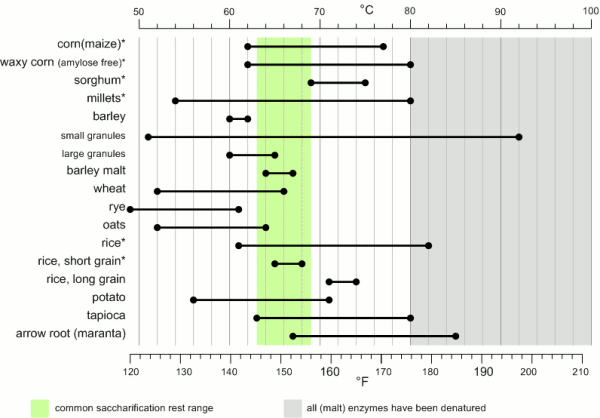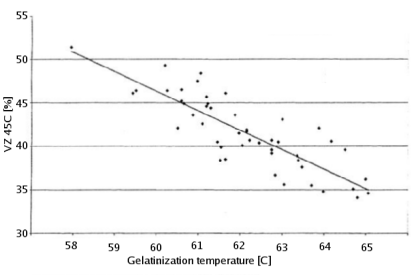Starch Conversion
96% (?) of the solids in brewing wort are carbohydrates. Proteins make up only 3% and the rest are β-glucans, vitamins and minerals. Of the carbohydrates more than 95% are products of the starch conversion that happens in the mash tun. As a result the starch degradation is the main purpose of mashing. It produces fuel that the yeast needs for fermentation from the insoluble starch found in malt and mash tun adjuncts. The extend to which this conversion happens will determine the strength (gravity or extract content) of the produced wort and its fermentability as well as other quality parameteres.
In mashing starch conversion is preceded by gelatinization of the starches. While this is not necessary for conversion, as plants do exactly this when they germinate, it greatly speeds up the process though the exposure of a lot of substrate (amylose and amylopectin) from the starch granule to the starch converting enzymes (mainly α- and β-amylase).
Gelatinization
Starch granules are insoluble in cold water and will absorb only little water. The form a suspension that quickly settles once agitation stops. As the water is heated (50+ C) more and more water is absorbed and the granules start to swell [Narziss, 2005]. The water absorbed can be up to 30x the starch granule
[Shetty, 2006]:
- gelatinization: heating in excess water, endothermic reaction, loss of crystalline order
- irreversible w/r to the shape of the granule
- amylopecting and amylose may form new structures when cooled down -> retrogradation
- during heating -> swelling to up to 30x its weight. reversible process
- retrogradation is cause for hard stale bread
[Donald, 2004]
- irreversible order -> disorder transition called gelatinization.
- swell, absorb water, leach amylose, loose crystallinity.
- birefringence is lost
- range is quite large for all granules 56-64 for wheat and potato but much smaller (1 C) for individual granules
- substantial swelling
- inital water absorption in the amorphous growth rings
- swelling driven process
- crystalline regions break open b/c of the swelling
- if water is limited (high density or presence of sugars) swelling doesn't take place as well and a melting of the crystalline sections needs to happen
- gelatinization temperature increases
- Maize starch: from 70C to 78C when placed in 25% sugar solution.
- sugar removes free water
[Briggs, 2004]
- sugar concentration raises gelatinization temperature
- enzymatic breakdown should happen before retrogradation occurs
- some starches require cooking temps between 90 and 120C (194-248F) before amylose lipid complexes are broken -> one of the reasons why cooking of some adjuncts is necessary.
- gelatinization temperatures of various starches (page 38), create table
[Narziss, 2005]
- starch is insoluble in cold water
- granules start to swell (50C +)
- then they get small fissures
- amylose leaches out
- amylopectin separates as gelatenous sheet
- viscous and sticky mass is formed\
- doesn't happen in mashing b/c of the enzymes
- but may cause problems in cereal cookers (especially rice)
[Kunze, 2007]
- 4 phases: ungelatenized, gelatinization, liquification, saccharification
- gelatinization temp dependent on growing conditions and crop year : 59 - 65C
[Kessler, 2008]
- VZ45 shows some correlation to gelatinization temperature
- gelatinization
- active enzymes
- emzyme temperature and pH optima
- mash parameters affecting conversion
References
- [Valclavik] Vickie A. Valclavik, Elizabeth W. Christian, Essentials of Food Science, Third Edition, Springer
- [Champe] Pamela C, Champe, Richard A. Harvey, Denise R. Ferrier, Biochemistry, Lippincott's Illustrated Reviews
- [Kunze, 2007] Wolfgang Kunze, Technologie Brauer und Maelzer, 9. Auflage, VLB Berlin
- [Narziss, 2005] Prof. Dr. agr. Ludwig Narziss, Prof. Dr.-Ing. habil. Werner Back, Abriss der Bierbrauerei, Technische Universitaet Muenchen (Fakultaet fuer Brauwesen, Weihenstephan). WILEY-VCH Verlags GmbH Weinheim Germany, 2005
- [Donald, 2004] A. M. Donald, Understanding Starch Stucture and Functionality, Chapter 5 in Starch in Food: Structure, Function and Applications By Ann-Charlotte Eliasson, CRC Press, 2004
- [Shetty, 2006] Kalidas Shetty, Food Biotechnology, CRC Press, 2006
- [Kessler, 2008] Dr.-Ing. Matthias Kessler, Dr.-Ing. Stefan Kreisz. Dipl.-Ing. Martin Zarnkov. Univ.-Prof. Dr.-Ing. Werner Back, Do Brewers need a starch modification index?, Brauwelt International, 2008/1




